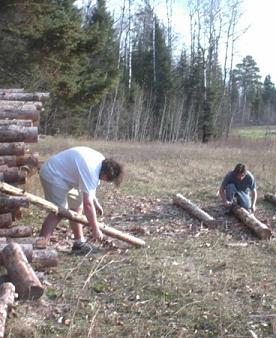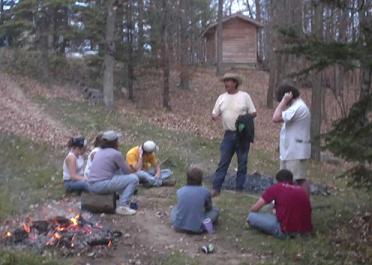| Native American Site Visits in the Context of Service Learning |
![PDF-NOTE: Internet Explorer Users, right click the PDF Icon and choose [save target as] if you are experiencing problems with clicking.](http://rsnonline.org/templates/rsntemplate-smallmasthead/images/pdf_button.png) |
 |
Michael D. McNally, Carleton College
Site visits are crucial to my aims in my courses on Native American religious traditions, but not site visits in isolation. They fit my pedagogical purposes insofar as they are elements of academic service-learning projects that give students more reason to be at the sites than their education alone. In this brief consideration of my experience at Carleton, a rural, liberal-arts college town one hour’s drive from Minneapolis/St. Paul, I will outline how I understand academic service learning and the rewards and challenges of site visits to Native American community centers in the Twin Cities and on northern reservations. Even for readers not contemplating the service-learning component, what follows can be helpful in thinking through the pedagogical aims, practical challenges, and rewards of site visits for courses on Native traditions. Service-Learning Courses in Native TraditionsEducators use various working definitions of academic service learning; for my purposes, service learning involves some measure of commitment to community service at the behest of Native community organizations, and structured reflection on that service experience such that it becomes integrated into the core learning of the course. It is the structured reflection that quickens such experiences, making them more than simply supplementary to the course. I have used community service and structured reflection on it with considerable success in two courses over three years. In “Native American Religious and Cultural Freedom,” an upper-level course that explores the historical, legal, and cultural contexts in which Native Americans have practiced their religions within the U.S., students engage in service projects generating public scholarship by researching pending claims to sacred lands, free exercise, and treaty rights. Here, though, I will focus on my introductory “Native American Religions” course, which aims to appreciate how religious traditions have served the region’s Lakota and Ojibwe communities in their efforts to live well in the context of colonization and dispossession. The course tries to confront stereotypes and to think reflexively about the category of “religion” as applied to what Native people describe as “ways of life.” I use service learning for at least three related reasons discussed in greater length elsewhere (McNally, forthcoming). The first is consonant with a distinctive Ojibwe pedagogy as I came to know it through the direction of my teacher, the late activist and poet Larry Cloud Morgan, and a group of elders on the White Earth Reservation. In part because of its rooting in an oral tradition, and in part because of its community orientation, Ojibwe tradition emphatically weds the transmission of cultural to communal responsibility. While there is nothing anti-intellectual about Ojibwe pedagogy, there is a conviction patterned in teacher-student relationships that cultural knowledge must be earned by students committed to use the knowledge for the betterment of the community. Student service-learning projects are by no means grand, but the admittedly small gestures can reorient a student’s learning accordingly. Second, service learning helps close the marked distance between much of the “book knowledge” on Native religions and the contextual realities to which Native religions have ministered in actuality. Ojibwe people broadly resist reducing their “way of life” to the label of “religion,” and while this is something of a truism as applied to the devout of any tradition, it makes particular sense to indigenous people (Martin 1999). What is more, Ojibwe people are broadly vigilant in maintaining that cultural and religious knowledge belong to the oral tradition and not to the fixed text with its perceived attendant orthodoxies. Although term-long service learning projects hardly create sustained, deep encounters with oral traditions, the very gesture can equip students with a critical purchase on the authority of the books and lectures they’re encountering in the classroom — and vice versa. Third, and perhaps most important, experiences with real Native communities and their very real needs are crucial because learning about Native American religious traditions involves as much unlearning as learning. Many students come to these traditions with images of and desires for “noble savagery,” and in particular for Native American “spirituality.” As cultural historians have shown, these images, projections, and desires run so deep in both popular and intellectual culture that they often go unrecognized by even the most critical thinkers among us (Berkhofer 1978, Deloria 1988). While I strive in my course designs, book selections, and lecture outlines to interrupt the dehumanizing way that many dominant representations of “real Indians” (along the lines of Dances with Wolves) obscure the realities of contemporary Native peoples’ lives in the context of colonization and racism, such efforts amount to little in comparison with what’s experientially possible in service learning. In these contexts, students encounter firsthand both the harsh economic, social, and physiological realities of Native life, as well as the artful ways that religious traditions inform, empower, and beautify lives lived amid such realities. In short, my goal through service learning is to take my students’ interest in Native spirituality that is often as heartfelt as it is misguided, to immerse it briefly through service into the lived realities of Native communities, and, thus politicized, to redirect and reshape student interest through structured reflection on the shape and contemporary vitality of Native American religions.
Site Visits in the Context of Service LearningTranslating such lofty theoretical aims into practice is hard work, with admittedly varying and often unpredictable success; but what does result is often refreshingly more real and consequential. Students bring varying levels of commitment and energy to the class, so I require a good faith effort towards at least ten hours of service per semester, and offer richer possibilities for service to the many students who want more. For a class of thirty, I prearrange five to six service-learning projects, one or two of which involve connecting with Native communities through the Web and campus education/organizing (e.g., the Gwich’in Steering Committee’s efforts on behalf of the Alaska Native Wildlife Refuge). Most students, however, want to make a deeper commitment to projects that involve site visits. These have included:
As most readers should appreciate, exchanges between Native communities and scholars and the institutions of higher learning that employ them are charged with long histories of exploitation of power inequalities (Mihesuah 1998). I don’t propose that modest service learning does much to address these inequities, but it does importantly reconfigure misguided expectations about who has what and how much to teach and to learn. I make arrangements for these projects based on relationships and trust I have developed over many years. I clarify the modest nature of the service that my students will offer and acknowledge that I don’t wish to burden already understaffed, overworked people with another group of outsiders to “train in.” I think it is crucial to place students with community leaders who are conversant with the students’ collegiate world, but it is also crucial to surround my students with Native community people whose distinctive cultural idioms challenge students to think differently about the world. Finally, I emphatically do not accompany the students in their work to mediate their experience for them. This has had the refreshing result of giving students a truer sense of critical purchase on my authority, course texts, and classroom priorities. My logistical workload is particularly heavy in the first four weeks of the course; I can’t make precise commitments to Native organizations, raise money, or make all arrangements until I know who my students are and how far their interest and commitment will carry. This is important, given that this process involves placing faith not only with my friends and contacts in the Native community, but more challengingly still, placing faith in my students to comport themselves with respect. Structured Reflection Is the KeyWithout structured reflection, field experiences alone do not generate articulate experience sufficient to transform learning in the course. Carleton’s location ensures that groups have at least an hour in vans to process their experience, and I am convinced this alone does as much to begin the process of structured reflection as anything formally stipulated by me, no doubt justifying the considerable expense of such trips — usually about $2,000 for a 30-student course, generously supported by Carleton. Student journaling can be helpful, but in my view that process encourages students to do their reflection in their own heads, without benefit of dialogue. For this reason, I structure reflection through formal group presentations and integrative takehome final essays that prompt students to reflect on the connections and disconnections between service-learning experiences and books, films, lectures, and visits from the course. Increasingly, I have come to appreciate the stipulated office-hour discussions with each student midway through the service or the week following a visit. It is here I can best help students identify frustrations — typically that they aren’t finding or haven’t found enough “Native religion” in their experience — and convert those frustrations into learning moments about their deep-seated preconceptions, or about the ways that Native “religion” has been nowhere and everywhere at once. Trusting in Seeds and Reaping the RewardsNot all students emerge as changed as I would hope by service learning and site visits. For some, there are simply too many other priorities in a term to delve deeply into this kind of work. For others, projects only confirm what remains for them the vast and disappointing distance between the Native people they meet and the “pristine” spiritualities they’d hoped to find. But for others, such jarring experiences succeed in reorienting them in ways that gratify me deeply when I hear them articulated in classroom presentations and final integrative essays. There was the physics major (whose photographs appear here) who was so moved by her service at White Earth and encounters with an elder there that she has committed to a year of Jesuit Volunteer Corps, to teach science on a Montana reservation. There were the students who worked through considerable frustration that they were getting too little exposure to Ojibwe “culture” in a magnet school preoccupied with meeting the basic needs of pupils with the city’s highest concentration of poverty, and who extended their commitment to weekly classroom assistance for another six months. Then there were the students who took a stroll outside the Minneapolis American Indian Center during a break in their work for the Feast for the Dead. A Native man who was sleeping on the ground outside the center arose to confront them, asserting they had no business being there “on Indian land.” Some were admittedly concerned for their safety, but when one student assured the man they were volunteering to help out with a feast and ceremony honoring the previous year’s dead, he tearfully confessed that he had been drinking out of loneliness after his mother’s recent death and asked them to go in and “say hello to her” for him. One could hear a pin drop as the group told this story in their class presentation. Their expectations for an authentic “Native American ceremony” were interrupted by the harsh realities of the street. They spoke with an awakened sense of urgency of how they had learned that most of the year’s deaths memorialized in the ceremony had been violent, including a victim of fatal police brutality. I suspect that this final story sheds light on how service learning can address one presenting problem we perhaps share in religious studies: how to arrange visits to places of other peoples’ ceremony that are meaningful for students and respectful of the practitioners. In the case of visits to Native American sites, added to the customary risk of voyeuristic academic tourism in the spiritual field of the “other” is the risk of posing as pilgrims seeking the presumed authenticity of “Native American spirituality.” Service learning does not resolve the challenge of simultaneously trying to respect the very boundaries we often wish to cross for the purposes of learning. It doesn’t guarantee students will be more than academic tourists or less than needy pilgrims. But service learning’s modest discipline and structured reflection, in my experience, helps students earn their keep, emboldens them to participate when invited and where appropriate, and promotes a view of Native religions that is not divorced from the realities of Native ways of living. In this, it has proved worth the risks. ReferencesBerkhofer, Robert. The White Man’s Indian. New York: Vintage, 1978. Deloria, Philip. Playing Indian. New Haven: Yale University Press, 1988. Martin, Joel. The Land Looks After Us: A History of Native American Religion. New York: Oxford University Press, 1999. McNally, Michael. “Indigenous Pedagogy in the Classroom: A Service-Learning Model for Discussion.” American Indian Quarterly, forthcoming. Mihesuah, Devon. Natives and Academics. Lincoln: University of Nebraska Press, 1998. |


 Michael D. McNally is Assistant Professor in the Religion Department at Carleton College. He is the author of Ojibwe Singers: Evangelical Hymns and a Native Culture in Motion (Oxford University Press, 2000), and he is currently writing a cultural history of Ojibwe eldership and religious authority.
Michael D. McNally is Assistant Professor in the Religion Department at Carleton College. He is the author of Ojibwe Singers: Evangelical Hymns and a Native Culture in Motion (Oxford University Press, 2000), and he is currently writing a cultural history of Ojibwe eldership and religious authority.

